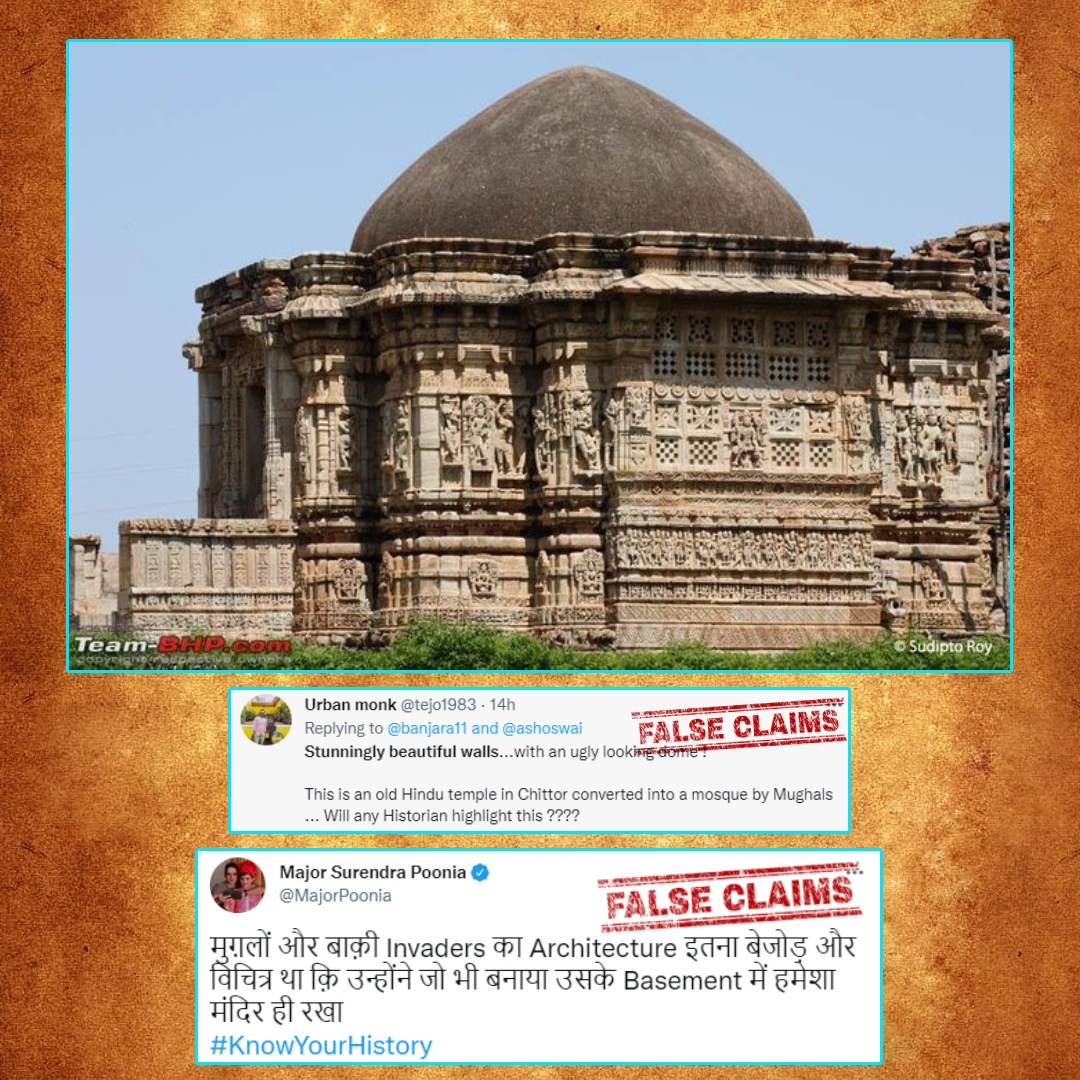
Image Credit: Twitter
This Temple In Rajasthan Converted Into Mosque By Mughals? No, This Is Jain Temple!
Writer: Jakir Hassan
A journalist at heart loves the in-depth work of reporting, writing, editing, research, and data analysis. A digital and social media enthusiast.
Rajasthan, 3 Jun 2022 10:57 AM GMT
Editor : Bharat Nayak |
As the founding editor, Bharat had been heading the newsroom during the formation years of the organization and worked towards editorial policies, conceptualizing and designing campaign strategies and collaborations. He believes that through the use of digital media, one could engage the millennial's in rational conversations about pertinent social issues, provoking them to think and bring a behavioral change accordingly.
Creatives : Jakir Hassan
A journalist at heart loves the in-depth work of reporting, writing, editing, research, and data analysis. A digital and social media enthusiast.
BJP Member Major Surendra Poonia tweeted a photo of the Jain temple with the claim that the structure is a Hindu temple that was converted into a mosque by Mughal invaders. The Logical Indian Fact Check team verifies the claim.
An image has gone viral across social media of a religious structure with the characteristics of a temple with a dome on its top. The image is being shared with captions implying that a temple has been wrongfully converted into a mosque.
The religious structure's image has gone viral across social media in the context of the current controversy surrounding the Gyanvapi mosque. Petitioners in the case have requested the Varanasi court to allow Hindu devotees to offer prayers in the mosque based on the claim that the mosque houses a shivling. The next hearing of the case would be held on July 4.
Claim:
The image shows a religious structure with carved adornments on its outer walls. The carvings are similar to other carvings observed in Hindu temples. On the top of the structure is a dome which is one of the dominant features of mosques.
The viral caption of the tweet implies that an old Hindu temple in Chittor was converted into a mosque by Mughals. BJP member Surendra Poonia shared the image with a caption, "मुग़लों और बाक़ी Invaders का Architecture इतना बेजोड़ और विचित्र था क़ि उन्होंने जो भी बनाया उसके Basement में हमेशा मंदिर ही रखा."
[English Translation: The architecture of the Mughals and the rest of the Invaders was so unique and strange that whatever they built, they always built it on top of a temple in its basement.]
Another user wrote, "Stunningly beautiful walls...with an ugly looking dome ! This is an old Hindu temple in Chittor converted into a mosque by Mughals ... Will any Historian highlight this ???? #GyanvapiMosque #TajMahalControversy."
It is being widely shared on Facebook and Twitter with a similar claim.
Fact Check:
The Logical Indian fact check team verified the claim and found it to be false. The structure is a Jain temple.
We conducted a reverse image search on the image and came across the following results on Alamy, a stock photo website. The image carries the caption: "Old Temple ruins. Rattan Singh Palace. Chittorgarh Fort. India"
We also came across this image on Alamy with the caption, "Old Hindu temple with a domed roof and intricate carvings on the outer walls, Chittorgarh, Rajasthan, India, Asia".
Taking this information into account, we conducted a keyword search and came across the following image. The image is uploaded on Wikimedia Commons stating the name of the temple as, 'Shringar Chori (Shringar Chauri).'
This prompted us to conduct another keyword search following which we came across this blog post. The blog post contained information about the structure alongwith several images of the structure from several angles. The blog describes the structure as a temple hosting a dome supported by a four-pillared structure with a small altar in the middle of it. It is remarked that the structure is a Jain temple. The structure is described as having two entrances on which the pavilions are built, in front of which there are two artistic pillars.
We also came across the viral mage on a website, Thinking Particle. According to the information given in the report, this is the Shringar Chauri temple built inside the Chittorgarh Fort which was built by Velaka in 1448 AD.
On the website of the Rajasthan government, Sringar Chauri is mentioned as one of the 'temples related to Hindus and Jains built inside the fort'.
We also came across the images of the structure on the website of the Indira Gandhi National Centre for the Arts (IGNCA) located in Delhi. The images show the board located near Sringar Chauri. The board reads: "Sringar Chauri The inscription on the pillar near the western door of the temple mentions that Velaka, the son of Kola the treasurer of Maharana Kumbha, built this temple and dedicated it to Santinatha in A.D.1449 and that it was consecrated by Jina Sagara Suri. The temple, which was later on covered by the massive wall built by Banbir is now kept open."
As per this article published on Amar Ujala on 26 May 2020, Kumbha of Mewar also known as Maharana Kumbha was the king of Mewar from the year 1433 to 1468. He is also remembered in history for the construction of forts and temples. The Kirti Stambha, which is also located in Chittor Fort was built during his reign as a monument to Jainism.
On the website of IGNCA, additional details about Sringar Chauri is there. On page 106 of Inventory of Monuments and Sites of National Importance, the following details were mentioned. The document mentions that the structure is a Jain temple which is not being used for religious purposes.
This report also mentions "Archaeological Survey of India: Report of a Tour in the Panjab and Rajputana in 1883-84, Vol. XXII" which was written by author A. Cunningham. On page 105 of this book, the following is mentioned, "Midway between magazine and bastion is a carved stone temple now called the Sringar-Chauri containing a canopied masonry dais and is said to have been built by the Jain treasurer of Rana Kumbha".
Conclusion:
The viral tweets claim that the structure depicted in the image is a temple that was converted into a mosque by Mughal invaders.
However, as per visual evidence and reports from IGNCA and ASI, the structure depicted in the image has a long-standing history. The structure is a Jain temple which was constructed by Velaka, the son of Kola the treasurer of Maharana Kumbha.
There is no mention of Sringar Chauri being converted into a mosque. Accordingly, we determined that the structure is not a Hindu temple that was converted into a mosque by Mughal invaders, as is claimed across social media. Hence, the viral claim is false.
If you have any news that you believe needs to be fact-checked, please email us at factcheck@thelogicalindian.com or WhatsApp at 6364000343.
Also Read: Viral Claim That India Today Edited Tilak Out From Indian Grandmaster's Forehead Is False
 All section
All section














